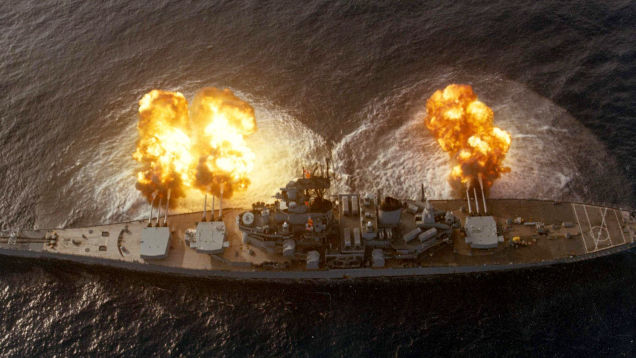Ukraine rebels, flattops and battlewagons, ISIS-hunting and Desert Storm nukes: Nine new Command scenarios available
 Miguel Molina has posted a new revision of the Command community scenario pack, the compendium of Command scenarios crafted by the user community. The new release contains nine brand-new scenarios:
Miguel Molina has posted a new revision of the Command community scenario pack, the compendium of Command scenarios crafted by the user community. The new release contains nine brand-new scenarios:
- They Came From The Museum, 2015: Soviet/Russian tactical aircraft have a long history of ‘inexplicably’ showing up in various conflicts under the hands of ‘rebel’, ‘advisor’ and otherwise non-official pilots. This scenario assumes that the “little green men” in Ukraine take this strong tradition one step further and piece together a hodgepodge air force from various odd sources, including a number of exhibits from the Luhansk Air Museum. How will these Cold War cast-offs and their mysterious pilots fare against Ukrainian air defences?
- The Battle of Langkawi, 1973: By 1973, the communist insurgency that erupted in Malaysia has taken control of most of the state of Kedah. They have captured a number of artillery pieces, armored cars, and other military equipment, including a number of aircraft. An international coalition, led by the UK, and including forces from Australia, New Zealand, and Singapore are assisting Malaysia in its fight against the insurgents. However, the Soviet Union, China, India, North Korea, and Cuba have all recognized the self-declared People’s Republic of Kedah – and will actively assist it against blockades of its ports in the Kedah region, including the island of Langkawi.
- The Clash Of Titans II, 2018: India started the year with intensive naval activity in both Indian Ocean and Arabian sea. The brief Indian incursion into littoral waters of French island Reunion was condemned by French diplomacy. Further diplomatic tension eventually resulted in a double embargo between France and India. A week ago, the French CVBG led by the Charles De Gaulle CV left Toulon naval base and headed to Suez. INS Vikramaditya with its escorts was ordered to head towards the Gulf Of Aden. Politics will continue by other means from now on.
- Closing the Kurile Gap (The War That Never Was) – US, 1989: The Soviet Pacific Fleet would have faced a difficult problem with geography if the Cold War ever went hot. Their largest base, Vladivostok, faces the Sea of Japan. Any units transiting to the Pacific either need to pass through the narrow Tsushima Strait, flanked by likely-hostile South Korea and Japan, or they need to head northwest and pass through the disputed Kurile Islands. The other major Soviet naval base, Petropavlovsk, opens to the Pacific. However, it is located at the end of the remote Kamchatka peninsula and has long, vulnerable supply lines. This scenario examines the Soviet Pacific Fleet’s ability to break out through the Kuriles, and the US Navy’s role in plugging the gap.
- Closing the Kurile Gap (The War That Never Was) – USSR, 1989: The Soviet side of the above scenario.
- Those Who Face Death, 2014: In this hypothetical “from the headlines” scenario ISIS has captured much more intact military equipment from the Iraqi and Syrian Armies; they also have the technical capabilities to put it to use. Expect to see American, Iraqi, Syrian, Iranian military equipment. You are hunting a convoy of artillery and APCs heading to Mosul from the south before turning west towards the Yazidi camp at Mount Sinjar. You will need to airdrop supplies and parachutists to the Yazidi camp to achieve success. You are sending British and American aircraft from bases in Turkey, Kuwait, and Cyprus.
- Log Bridge, 1989: World War III has been raging. The fighting over Keflavik has been so heavy that what remains of the airfield, currently held by NATO, is unusable. At the same time, the fighting in Europe has pl aced demands upon available resources that preclude either side sending long range aircraft to attack or defend Iceland. The fate of Iceland will therefore be decided by a decisive surface battle. The big guns are coming out – literally.
- Nuclear Storm, 1991: Desert Storm is underway, and the unthinkable has happened: Saddam’s forces have launched chemical attacks on coalition troops, with significant casualties. Now a retaliation is in order – to illustrate within limits that some lines are not to be crossed.
- No Time for Mischief, 1995: Mischief Reef is in a disputed area of the South China Sea. In 1995, China angered the Philippines by occupying the reef and constructing structures on it, ostensibly as shelters for fishermen. In history, the matter did not escalate into violent confrontation. This scenario assumes the government of the Philippines has taken a more aggressive approach, assuming that if worst comes to worst they will be backed up by the United States.
As always, the community scenario pack is available for download at the WarfareSims download section: http://www.warfaresims.com/?page_id=1876





